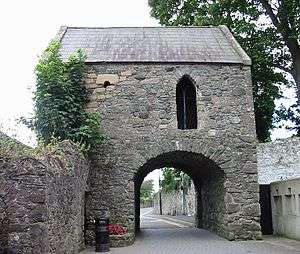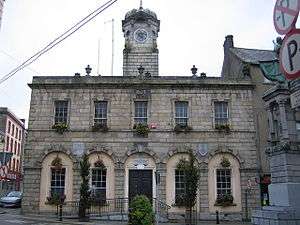Tholsel
The term Tholsel (Irish tólsail) refers to extant and former public buildings in Ireland's towns and cities.
The term is derived from the Middle English tolsell, from tol, toll ("toll") + -sell (Old English sele "hall", "house").[1][2] Similar buildings called tolseys or tolsey houses are found in some English towns and cities, including Burford, Gloucester and Wotton-under-Edge.
Buildings described as, or called, a Tholsel have been used as a town hall, a courthouse, a town gate, a prison, a market house, a council chamber, a customs house, a guildhall, and a place where tolls were collected.
The Tholsel building in Dublin was a late medieval building, erected as a merchants' hall at the corner of Nicholas St. and Christ Church place, next to the Church of St. Nicholas Within.[3] In the late 15th century, it was the home of the first mechanical public clock in Ireland. In the late eighteenth century, the Dublin Tholsel was used as a courthouse, being notable as the location where many Irish people, convicted of crimes, were sentenced to be transported to exile in Australia. It was demolished in 1820. There was also a Tholsel at Galway from 1639–1822 [4][5] The Tholsel in Limerick was located in Mary Street in the old Englishtown district of the city. It served as the headquarters of Limerick Corporation until it moved to the Exchange building on Nicholas Street. It was demolished in the early 20th Century after it fell into dereliction.
Tholsels survive at the following locations throughout Ireland:
| Name | Location | Construction year | Image |
|---|---|---|---|
| Tholsel, Town Gate | Carlingford | 1450[6] |  |
| Main Guard | Clonmel | 1675[7] | %2C_The_Main_Guard_-_geograph.org.uk_-_260570.jpg) |
| Tholsel | Drogheda | 1770 | .jpg) |
| Tholsel | Kilkenny | 1761[8] |  |
| Tholsel | New Ross | 1806[9] |  |
See also
- Market Houses in Ireland
- Tolbooth for some of the equivalent buildings in Scotland
- Tolsey.
References
- ↑ http://quod.lib.umich.edu/cgi/m/mec/med-idx?type=id&id=MED46258&egs=all&egdisplay=open
- ↑ http://www.merriam-webster.com/dictionary/tolsey
- ↑ "1682 - Tholsel, Dublin - Architecture of Dublin City, Lost Buildings of Ireland - Archiseek - Irish Architecture". 9 December 2011.
- ↑ "The Tholsel at Galway (1639-1822)": 77–85. doi:10.2307/25535475 (inactive 2016-04-26). JSTOR 25535475.
- ↑ "1639 - Tholsel, Galway - Architecture of Galway, Lost Buildings of Ireland - Archiseek - Irish Architecture". 13 January 2013.
- ↑ "1450 – The Tholsel, Carlingford, Co. Louth – Architecture of Louth". Archiseek.com. Retrieved 2015-06-16.
- ↑ "The Main Guard". Heritage Ireland. Retrieved 2015-06-16.
- ↑ "The Tholsel – Kilkenny City and County Portal". Kilkenny.ie. Retrieved 2015-06-16.
- ↑ "Newrossmarket". Irishantiquities.bravehost.com. Retrieved 2015-06-16.